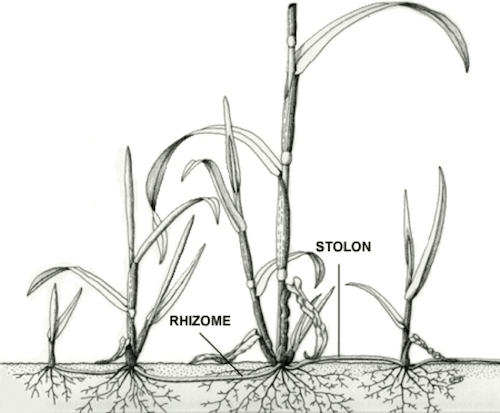The basic growth habits of a grass type help determine which is best for your lawn and how to maintain it for top performance.
Turfgrasses can be divided into two main categories based on how the buds in the crown of the plant produce new growth.
 All turfgrasses are “mother plants,” with buds within their crowns that are able to produce the new, independent plants called tillers. These tillers are like “daughter plants,” or “clones,” having the same genetic makeup as the mother.
All turfgrasses are “mother plants,” with buds within their crowns that are able to produce the new, independent plants called tillers. These tillers are like “daughter plants,” or “clones,” having the same genetic makeup as the mother.
As more tillers emerge and grow, over time they will surround the mother plant in a cluster or bunch.The types of grasses that only produce tillers have a bunch type growth habit. Turf-type tall fescue is an example of a bunch type grass.
Some turfgrasses also have buds within the crown that are able to emerge and develop a lateral stem as an additional form of reproduction.
When these lateral stems develop aboveground, along the surface of the soil, they are called stolons. Nodes spaced along the lateral stem each contain a bud capable of producing a new, independent plant.
Some lateral stems develop underground, within the soil. They are called rhizomes. They also have bud-containing nodes for reproduction.
The new plants produced from the buds of either stolons or rhizomes also are clones of the mother plant. As the lateral stems grow, the new plants that emerge are spaced farther away from the mother plant.
The types of grasses with the ability to develop either or both of these lateral stems have a spreading type growth habit. Some grasses, such as Bermudagrass, can form both stolons and rhizomes.
When stolons are the only type lateral stem a spreading grass produces, it is called a stoloniferous grass. St. Augustine is one example of a stoloniferous grass. When rhizomes are the only type of lateral stem a spreading grass produces, it is called a rhizomatous grass. Kentucky bluegrass is one example.
Because spreading grasses form a network of grass plants, they can be grown as sod.
With more than one form of reproduction, spreading grasses can recover from damage, filling in bare spots more quickly than bunch grasses.
This information provided by The Lawn Institute – www.TheLawnInstitute.org